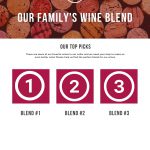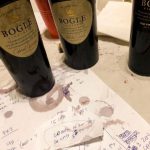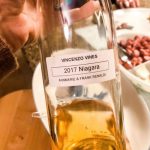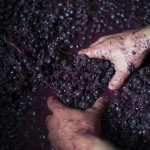How to Throw a Blending Party
When throwing a wine blending party think about the style of wine you want to create. Are you looking for a fruit forward blend? Are you wanting a Bordeaux, earthier style blend? Once you decide on the style of blend grab samples of the wines you want to utilize. I’d suggest putting them into unmarked bottles with numbers on them or you can put them into pitchers with numbers on them. With the wines “blind” people will try be more creative and less apt to going for only Cabernet.
Next set up your blending stations.
- Each blending station should have a glass for each wine being used and a glass for the blended wine
- A small pipette
- 100 mL graduated cylinder
- Wine Blending Sheet
- Pen or pencil
Musto’s Wine Blending Sheet
(email cmusto@juicegrape.com for your free download)

Once you have everything set up it’s time to start blending! Have fun!
Here are a few popular blends to help get you and your family started.
- Bordeaux Blends – Cabernet, Cabernet Franc, Merlot, Petite Sirah, Petite Verdot, Malbec
- Chianti – 75% Sangiovese, usually finished with Barbera
- Super Tuscan – Cab, Sangiovese, Syrah, Cabernet Franc
- Rhone Blends – Grenache, Syrah, Mourvedre, Cinsault, Carignane
- White Rhone blends – Marsanne, Roussanne, Viognier, Grenache Blanc
- White Bordeaux – Sauvignon Blanc, Semillon, Muscadelle
Remember – at the end of the day it’s all about which blend you enjoy the most!
MWG is here to help you make the wine that you love. Below are more blog posts and videos about Blending Wine. Take a look for more wine blending inspiration.
Blog Post: Beginner Blending Wine by Winemaker Chris Pallatto
How to Blend Your Wines Step by Step Video
Photos from a wine blending party with the American Wine Society
Interested in making your own wine? Contact Musto Wine Grape at sales@juicegrape.com or 877-812-1137. Cheers to Winemaking!
The Winemaker’s Think Tank: Vol 36 – “If I want to make a blend, do I mix the grapes together when I crush, or ferment them separately and blend later?”
What’s the Winemaker’s Think Tank?
Every Thursday we will post about a few frequently asked questions that our winemaker has answered. If you have a winemaking question you would like to have answered, please email us at support@juicegrape.com and we will try to get into next week’s post. Cheers! 🙂
If I want to make a blend, do I mix the grapes together when I crush, or ferment them separately and blend later?
There are many approaches to creating a blended wine and the chosen path is directly influenced by the desired end result. Blending at crush is often referred to as a field blend. The winemaker may choose to blend at crush when 80% of the blend is one grape. Using cabernet sauvignon as an example, a winemaker may add in a crate or two of Petite Syrah or Petite Verdot to enhance the dark color of the Cabernet Sauvignon. The winemaker may choose to add a crate or two of Cabernet Franc to enhance the spiciness and perceived acidity of the wine. Adding a small amount of a different grape to the larger percentage of the dominant grape in a blend will change the wine subtly, enhancing an aspect of the original grape that may be lacking such as color or acidity.
If the winemaker would prefer to have greater and much more finite control over the flavors in the resulting blend, fermenting each varietal individually would be more advantageous. Different yeast strains may be used on different varietals to enhance specific varietal characters. After a period of separate bulk aging, the wine maker can make different sample blends to determine the final blend of the wines they desire. Perhaps the entire quantity of a varietal will not be needed for the blend or perhaps only small additions of one varietal to another will be necessary to create a balanced final product. The winemaker can create more than one blend with a few separately vinified wines as changing the varietal percentages can greatly affect the final product.
We hope this information helps with your winemaking. If you have any follow up questions or winemaking questions in general, please email us at support@juicegrape.com.














Recent Comments